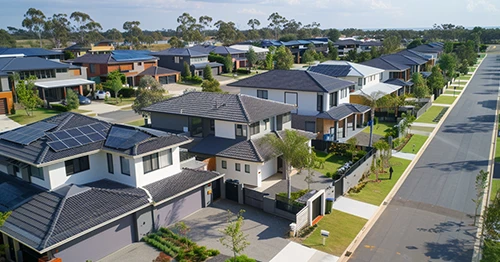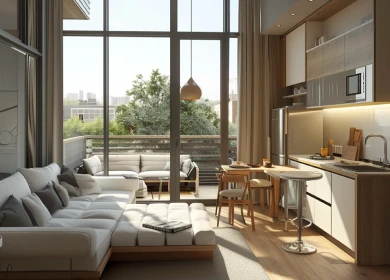Updated: 05 Dec, 2024
The ANZ CoreLogic Housing Affordability Report August 2022 has shown a bit of improvement in affordability due to the decline in home values.
The report analysed housing affordability based on four metrics:
- Ratio of dwelling value to household income
- Years required to save a 20% deposit
- The portion of income required to service a new mortgage
- The portion of income required to service rent
Let’s take a closer look at each metric.
Dwelling Value To Household Income Ratio
The home value-to-income ratio has declined across the combined capital cities – a sign of improving affordability. It fell from a record high of 8.4 in March 2022 to 8.3 in June.
With the declining home values and gradually rising income levels across Australia, this ratio is expected to improve during the housing market’s downswing, despite the challenge of rising interest rates.
Years Required To Save A 20% Deposit
Across the combined capital cities markets, the time required to save for a deposit fell for the first time in nearly two years in the June quarter, although the decline was marginal.
The time to save a deposit for the average house on the average income has decreased to 11.11 years from 11.14 years – a decline of about 11 days.
The more expensive capital cities have shown a decline in dwelling values since September 2020. The time required to save a deposit reduced by three months in Sydney and Melbourne this June.
A more subtle decrease can be observed in Canberra and Hobart, where the time required to save a deposit has decreased by a month this June.
Home values declined 2% nationally for the three months to July. Declines in home values are expected to become more widespread.
The Portion Of Income Required To Service A New Mortgage
The portion of income required to service a new mortgage has increased from 40.4 % in March up to 44% in June – the highest proportion since June 2011. Moreover, the proportion of income needed for rental payments on new households has increased from 30.3% in the previous quarter to 30.9%.
Mortgage costs as well as rents are increasing, which ultimately tightens household budgets.
Mortgage serviceability decreased the most where property values continued to rise in the June quarter. In Adelaide, the proportion of income needed to service a mortgage jumped to 42.6% in June, from 37.4% in March. Similarly, in Brisbane, it increased by 4.5 percentage points, to reach 41.8% in June.
The Portion Of Income Required To Service Rent
The percentage of the median household income required to pay the median rent on a new lease as of June is 30.9%, up from 30.3% in the previous quarter.
Higher domestic demand and a slow supply of rentals have caused a shortage.
Amid decreasing property value and increasing rent, challenging times lie ahead for renters with little to no savings. However, it is a favourable time for renters with high savings to consider buying a home.
If you are thinking of buying a house in a downswing of the property market but you think making the repayments would be a challenge, our mortgage brokers can provide their professional assistance. Call us on 1300 889 743 or enquire online today!
How We Can Help You Overcome Challenges And Buy A Home
Increases in mortgages and rent, as a portion of the average income, have made buyers sceptical; but our mortgage brokers can help you find a deal that works for you. Read on to learn more!
Low-Deposit Options
First-home buyers can access several government grants and schemes. They can also purchase a new or existing home with a deposit as low as 5% of the property value – or even 2% in some cases. If you wish to use any of the grants or schemes, then discuss it with your mortgage broker.
If you are an expat, you can borrow up to 90% and those with permanent residency (PR) can get a home loan for up to 80%. Just because you are earning in foreign currency doesn’t mean you cannot get a competitive interest rate. Generally, lenders consider only 60% of your income in foreign currency but our brokers know lenders that consider 80-90% of your income.
You don’t need to miss out on a chance to enter the property market just because you have bad credit. With a good source of income, you can borrow 90-95% with bad credit if you have saved enough for a deposit of 8% and stamp duty.
Paying Higher Rent
Rent has increased and it’s expected to grow in the future. So, instead of paying high rent, it might be a good idea to buy a home in the declining property market.
If you wish to analyse your situation, then use our Rent vs Buy Calculator to get clarity.
Higher Borrowing Power
Since the portion of income needed for mortgage serviceability has increased, your borrowing power will take a hit. Other factors that affect borrowing power include your existing debts, the type of loan, and the lender you choose.
One of the ways to increase your borrowing power would be cancelling your unused credit cards and reducing the limit on the ones in use. Also, cutting down on your discretionary spending is a step toward increasing your savings. If you want to know more about ways to improve your borrowing power, then click here.
Buy Now or Wait?
If you can buy now, you increase the likelihood of getting your dream house, as there is more stock in the market but there are fewer buyers.
Interest rates are rising but if you can cope with the rising interest rates for a few years, then purchasing is likely to benefit you in the future. Eventually, the interest rate is expected to go down.
Every person’s situation is unique and requires a unique solution. Share your situation and get to know different possibilities from our experienced mortgage brokers.
Call us on 1300 889 743 or complete our enquiry form now to get in touch with our mortgage brokers!





